Hickok Tube Testers
Hickok Tube Testers
The number one name in vintage tube testers is Hickok, without any doubt. Their name is held in the highest esteem, and Hickok tube testers are very much sought after today. Although they manufactured quite a large number of tube tester models (beginning in 1928!), today’s audio ‘experts’ seem to only covet the later models. A very early model (though certainly not the earliest model I’ve seen) is the 510X, which also doubles up as a VOM. An example can be seen below.
 Hickok 510X is not as coveted as many other Hickok tube testers.
Hickok 510X is not as coveted as many other Hickok tube testers.
Not quite what you thought it would be, is it? This model was manufactured up until approximately 1935, during which time most every model of tube tester was superseded by an ‘upgraded’ version, complete with a new model number. The 510X had the ‘drawback’ of having no room for a roll chart, thanks to the VOM function. This model was replaced after the war years with the 530B, which thankfully had the roll chart, as well as sockets to test the ‘new’ miniature tubes. Hickok really had quite a colorful history, and here we have but a very small sampling of the advertising/catalog inserts I could find. Most Hickok advertising states that a tube is ‘tested under simulated operating conditions’, although I have never owned a Hickok that could put 500VDC on the plates of an EL34. To be fair, most tube testers that claim ‘operating conditions’ actually do have voltages similar to television and radio equipment of that era; guitar amplifiers are a horse of quite a different color. Let’s check out some of the vintage advertising below.
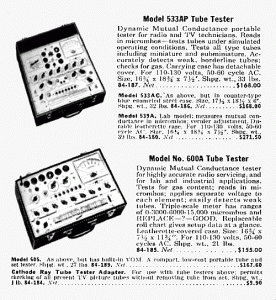
Hickok tube testers were quite expensive in their day.
The ad above is from the January 1953 issue of Radio-Electronics. The prices seem quite extraordinary for the 1950’s, and even today I can’t imagine how long it took a repairman to save that kind of money. The Model 539c, listed below, is the most sought after Hickok tube tester, and commands incredible prices on the open market (i.e. eBay). Their popularity may be explained in part by the observation that Hickok manufactured the ‘539’ model (including the 539a, 539b, and 539c) from about 1948 right up until approximately 1975, and there appears to be an extraordinary amount of these testers available.
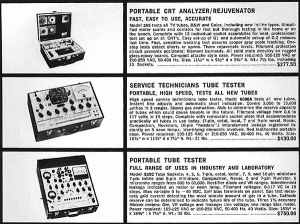
Later day Hickok catalog shows the 539c very expensive.
Here along side a CRT tester/rejuvenator we have some later day advertising for Hickok tube tester models 6000A and the guru-approved 539c. Damn, but they are expensive. What made them so expensive? Mr. Hickok himself manufactured meter movements before entering into the test equipment business. Most Hickok testers feature real glass for their meters, and pretty elaborate D’Arsonal-style movements. These are important, but don’t affect the accuracy or validity of the reading. These are still two popular testers to find on eBay, and the prices haven’t changed much.



Hickok Model 121 above looked expensive for the serviceman of 1959.
The ‘Cardmatic’ tube tester series we saw previously had more than model(!), as seen above left is the advertising for the Model 121. Here the Model 121 is advertised as being the low-cost alternative to the more expensive(!) Model 123A. I’m not sure how it can ‘pay for itself’, but I can’t imagine the retailer letting me take one home claiming the tester will indeed ‘pay for itself’. In 1959, I believe $249.50 would easily exceed many a technician’s weekly paycheck. To remind you that Hickok made much more than just tube testers, above center is the ad insert from the October, 1967 issue of Radio-Electronics. To understand just how expensive it was to own a Hickok anything, note that a ‘general purpose 4mHz oscilloscope’ for your bench costs $635! That would take the average repairman about an entire month to make that much money, even in 1967. The ‘portable’ oscilloscope, aimed at the TV repairman, is still $219.95. I’ve seen tube testers after they’ve been bouncing around in the service van for many years; I can only imagine what a $219.95 oscilloscope looked like after the same treatment. The thing to keep in mind is that the Model 800 (above right) was definitely not their top-of-the-line unit, yet it was still priced quite a bit higher than the Superior TV-12 or the Eico 666 tube tester, as examples. It is priced comparably to the B&K 650, all of which also test transistors. Advertisements invariably show Hickok tube testers originally priced much higher than many other brands, which partially accounts for their high resale value today.

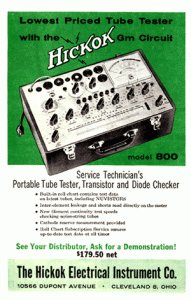
1962 advertisement proclaims Model 800 as ‘Lowest Priced Hickok’, and 1964 advertisement proves it.
Above left is an ‘alternate’ advertisement for the Hickok 800. Again, the ad proclaims this as the ‘lowest priced’ Hickok available. By my math, if you were earning approximately $2.25 an hour in 1962, you could devote an entire two-week paycheck towards the purchase of this tube tester. According to The American Institute For Economic Research, $179.50 in 1962 is the equivalent to $1,284.44 in 2008. Compare the retail price of a Hickok 800 to the retail price of a Hickok 539c, which would require you to earn approximately $9.35 an hour in 1962, and earmark your entire paycheck for the luxury of owning this most highly regarded tube tester. According to The American Institute For Economic Research, $750 in 1962 is the equivalent to $5,366.72 in 2008. Above right is an ad pulled from the November, 1964 issue of PF Reporter for the Model 6000A. This ‘new’ tester no longer has provisions for checking 4/5/6-pin tubes, but can test all the latest tubes, including Nuvistors and Compactrons.
An unusually rare Hickok tester was developed in 1965, perhaps in answer to the ‘average’ TV technician complaining how expensive Hickok test equipment was! Below is a sample advertisement for the Hickok 799 tube tester, dubbed the ‘Mustang’.
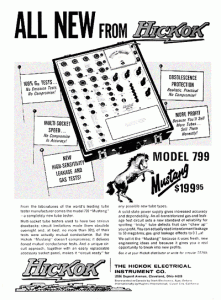
Even Hickok was known to sling a little BS in their advertisements.
Taken from the July, 1965 issue of PF Reporter, the advertisement above is ‘proof’ even Hickok could resort to hype and misleading advertising. At first it would appear that the Mustang would be an ideal tube tester; manufactured by the most famous name in tube testing, this unit should be a ‘no compromise’ unit, as promised. But is it? ‘
- 100% Gm Tests… No Emission Tests, No Compromise!’ Well, how do you measure the ‘Gm’ of a GZ34? The ad further compares itself to other tube testers, and mentions ‘… at best, no more than 10% of their tests were actually mutual conductance.’ The truth is no tube tester measures actual mutual conductance; they are measuring the AC gain capabilities of the tube, and at one (usually lower than ‘real world’) plate voltage. Lastly, the Mustang connects all tubes as triodes, which could easily be construed as a compromise.
- ‘A solid-state power supply gives increased accuracy and dependability.’ So, my 539c doesn’t have this ‘accuracy’ and ‘dependability’? I have a hunch then even though the 799 is pretty rare, they will not command as much respect from the modern tube ‘guru’, nor will they garner as much hype or cash on eBay as a 539c.
- ‘An all-transistorized gas and leakage test circuit sets a new standard or reliability for spotting ‘tricky’ tube defects that can ‘chew up’ your profits.’ This ‘new standard’ was used by B&K (albeit with a tube) for a few years before the Mustang was thought of.
The Mustang ‘borrowed’ a few layout ideas from B&K as well. Common tube settings were printed right on the panel, trying to speed up the process. I have only seen a very few Hickok 799 tube testers, and I own one of them. They are a nice tester; they calibrate very easily, and seem to operate smoothly. Would I use it as my ‘go to’ tester? Probably not. From the same era, most other B&K tube testers are cheaper, set up as fast, and test a 6L6 as a 6L6, and not as a triode. It’s no wonder more TV shops used B&K test equipment than any other brand, including Hickok.
There are many models of Hickok tube testers, and I have only touched on a select few. There are also many websites devoted to these testers, and below is another ‘select few examples’. Some will have manuals you can download, as well as calibration procedures. Also keep in mind that many discussion groups regularly bring up the subject of Hickok tube testers. If you are lucky enough to own a Hickok tube tester, you owe it to yourself to visit these sites. You should also buy at least a handful of spare 83 tubes, as well as #49 bulbs and #81 bulbs. Those who have ‘been there, done that’ know what I am talking about. Hickok would be just a faint memory today, were it not for the military sector. Due to their high retail prices, not many ‘civilian’ radio or television service technicians could afford a Hickok tube tester (or any other piece of Hickok test gear). But the military, known for paying $385 for a ‘mil spec’ hammer, seemingly bought a tube tester for every enlisted man. These testers now show up like Jehovah’s Witnesses all over eBay. The most popular, the TV7, is a very good tester. Read up on the various models, and decide if you’d rather make a mortgage payment or own a twenty-five pound boat anchor that cannot test ‘modern’ tubes. Remember, Hickok played up their ‘Dynamic Mutual Conductance’ circuit to death, so it is exactly the same tester under the panel of a 533A as it is in a TV7. The military paid as much as $1130US for that TV7 tester between 1960 and 1982(!), meaning they are very plentiful today.

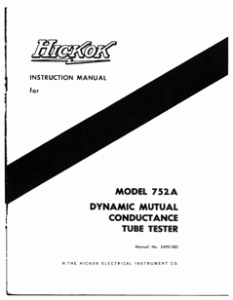
Can you see a difference? Is that difference worth $34?
I am always amazed that people will pay for photocopies of tube tester manuals on eBay, when most of them can be downloaded for free. Original manuals might be worth buying (if your tube tester is immaculate, and an immaculate manual would complete ‘the picture’), but recently an original Hickok 752 manual fetched $36US via eBay. I downloaded the manual for my very same tube tester, and for a total cost of less than $2 had it bound into a spiral ‘book’. Buying photocopies makes sense only if you cannot find a ‘free’ version, and/or you are too lazy to download and print your own manual.


The entire article seems to be a complaint about the the Hickok’s costs back in the day. This would have been a good article sans whining.
I don’t agree. I’m sorry you see it that way. I discuss all aspects of their range of machines and agree that there were and are still a premier tube tester. I also mention their cost as even in their prime they were an expensive piece of test equipment and many/most tech’s used more affordable alternatives. Not whining, simply stating the facts as I see them.